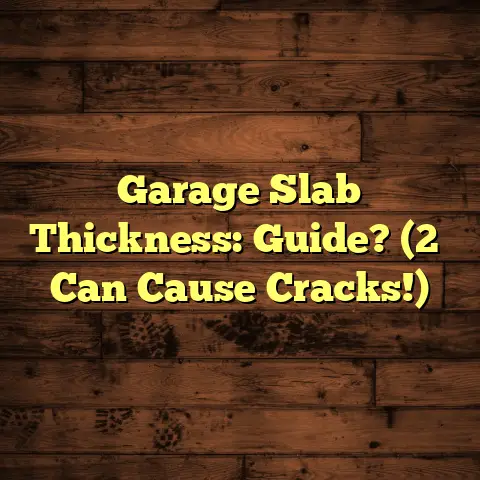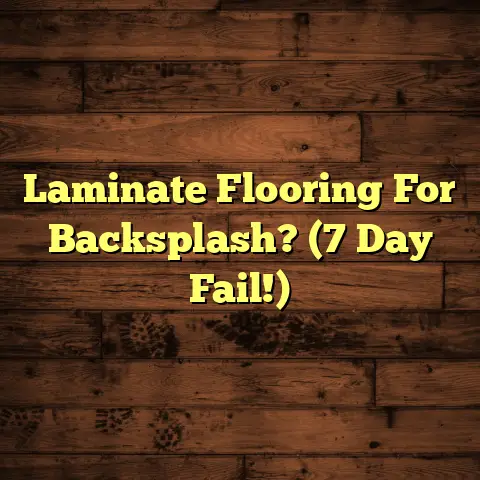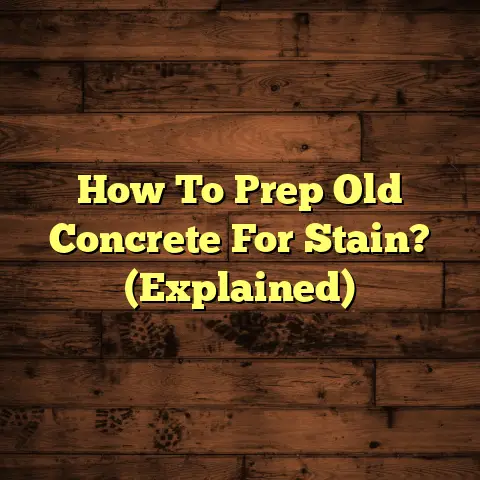Polyurethane Floor Finish: Pro Tips? (1 Mistake!)
I’ve spent years knee-deep in sawdust, transforming dull floors into showstoppers. And believe me, the right finish makes all the difference.
Flooring upgrades? They’re not just about aesthetics, are they?
They’re about injecting life into a space, boosting its value, and creating a foundation for memories. And the finish? That’s the unsung hero.
Let’s dive into the world of polyurethane and unlock the secrets to a flawless, long-lasting finish. Trust me, you’ll thank me later.
Understanding Polyurethane Floor Finish
So, what is polyurethane? Simply put, it’s a synthetic resin that forms a tough, protective layer over your floors.
Think of it as a shield against scratches, spills, and everyday wear and tear. It’s available in two main types: oil-based and water-based.
-
Oil-based: This is the classic choice. It provides a warm, amber tone and is known for its durability. However, it has a stronger odor and longer drying time. I’ve found that oil-based poly tends to highlight the natural grain of the wood beautifully.
-
Water-based: This is the modern marvel. It’s low-VOC (volatile organic compounds), dries quickly, and has a clear finish that doesn’t yellow over time. It’s a great option if you’re sensitive to smells or want to maintain the wood’s natural color.
The chemical composition? Complex, of course. But essentially, it’s a polymerization process where isocyanates and polyols react to form a durable film.
This film bonds to the wood, creating a barrier against moisture and abrasion. Different types of wood react differently.
For example, I’ve noticed that oak takes polyurethane exceptionally well, while some exotic hardwoods might require special sealers to prevent issues like tannin bleed.
The advantages of using polyurethane are numerous:
- Durability: It’s tough stuff, resisting scratches, dents, and abrasions.
- Scratch Resistance: Keeps your floors looking newer, longer.
- Ease of Maintenance: Simple cleaning with a damp mop is usually all it takes.
Compared to other finishes like wax or varnish, polyurethane offers superior protection and longevity. I’ve seen floors finished with polyurethane last for decades with proper care.
Upgrading Your Floors with Polyurethane
Why upgrade your floors? Well, there are tons of reasons. Maybe you’re:
- Renovating your home: New floors can completely transform a space.
- Selling your property: Updated floors can significantly increase its value and appeal.
- Simply refreshing a space: Sometimes, all it takes is a new finish to breathe life back into tired floors.
A high-quality polyurethane finish can dramatically enhance the look and longevity of your floors. It can bring out the natural beauty of the wood, protect it from damage, and make it easier to clean.
Let’s look at different flooring types:
-
Hardwood: Polyurethane is the go-to choice for hardwood floors. It provides excellent protection and enhances the wood’s natural grain. I always recommend at least three coats for high-traffic areas.
-
Engineered Wood: Polyurethane can also be used on engineered wood, but it’s crucial to check the manufacturer’s instructions. Some engineered wood floors have a thin veneer that may not withstand heavy sanding.
-
Laminate: While laminate floors often have a pre-finished surface, you can apply polyurethane for added protection. However, it’s essential to use a product specifically designed for laminate to ensure proper adhesion.
I’ve seen firsthand how a new polyurethane finish can completely transform a room. It’s like giving your floors a brand-new lease on life.
Applying Polyurethane Floor Finish: The Pro Tips
Alright, let’s get down to the nitty-gritty. Applying polyurethane is an art, and like any art, it requires preparation, skill, and patience.
Preparation
This is where the magic begins! You’ll need to ensure the floor is:
-
Cleaned: Vacuum thoroughly to remove dust, dirt, and debris. Then, use a damp mop with a mild detergent to clean the surface. Let it dry completely. I often use a tack cloth to pick up any remaining dust particles.
-
Sanded: Sanding is crucial for creating a smooth, even surface and ensuring proper adhesion. Start with a coarse grit sandpaper (e.g., 60-80 grit) to remove any existing finish or imperfections. Then, gradually move to finer grits (e.g., 100-120 grit) to smooth out the surface. Finally, use a very fine grit (e.g., 180-220 grit) for the final sanding.
-
Repaired: Fill any holes, cracks, or imperfections with wood filler. Let it dry completely and sand it smooth. I prefer using a wood filler that matches the color of the wood to minimize visibility.
I can’t stress enough how important preparation is. A poorly prepared floor will result in a poor finish, no matter how skilled you are.
Choosing the Right Product
Selecting the right polyurethane finish depends on several factors:
- Floor Type: As mentioned earlier, different floor types require different products.
- Usage: High-traffic areas require a more durable finish.
- Desired Look: Oil-based poly provides a warm, amber tone, while water-based poly is clear.
- VOC Levels: If you’re concerned about VOCs, choose a low-VOC water-based polyurethane.
I always recommend reading the product label carefully and following the manufacturer’s instructions. Don’t be afraid to ask for advice at your local hardware store.
Application Techniques
Here’s where your inner artist comes out. There are a few ways to apply polyurethane:
-
Brush: Ideal for small areas, edges, and corners. Use a high- quality natural bristle brush for oil-based poly and a synthetic brush for water-based poly. Apply thin, even coats, overlapping each stroke slightly.
-
Roller: Great for larger areas. Use a short-nap roller for a smooth finish. Apply thin, even coats, rolling in the direction of the wood grain.
-
Sprayer: The fastest and most efficient method for large areas. However, it requires specialized equipment and skill. I recommend practicing on a scrap piece of wood before tackling the entire floor.
Regardless of the method you choose, always apply thin, even coats. Multiple thin coats are better than one thick coat, which can lead to runs, drips, and bubbles.
Drying and Curing Times
Patience, young Padawan! Drying and curing times are crucial for optimal results.
- Drying Time: The time it takes for the polyurethane to dry to the touch. This can vary depending on the product, temperature, and humidity.
- Curing Time: The time it takes for the polyurethane to fully harden and reach its maximum durability. This can take several days or even weeks.
Always follow the manufacturer’s instructions for drying and curing times. Avoid walking on the floor until it’s fully cured.
Safety Precautions
Safety first! Polyurethane can be harmful if inhaled or ingested.
- Ventilation: Work in a well-ventilated area. Open windows and doors, and use a fan to circulate air.
- Personal Protective Equipment (PPE): Wear a respirator, gloves, and eye protection.
I always err on the side of caution when it comes to safety. It’s better to be safe than sorry.
Common Mistakes When Applying Polyurethane
Okay, let’s talk about mistakes. We all make them, but knowing what to avoid can save you a lot of headaches (and money!).
Here are some of the most common pitfalls:
- Skipping the Sanding Process: This is a big no-no. Sanding is essential for creating a smooth, even surface and ensuring proper adhesion.
- Applying Too Thick a Coat: Thick coats can lead to runs, drips, bubbles, and uneven drying.
- Ignoring Environmental Conditions (Temperature and Humidity): Extreme temperatures and humidity can affect the drying and curing process.
- Not Allowing Adequate Drying Time Between Coats: Applying the next coat before the previous coat is fully dry can lead to adhesion problems and a cloudy finish.
But there’s one mistake that I see time and time again, and it’s arguably the most critical:
Improper Surface Preparation
I cannot emphasize this enough: Improper surface preparation is the kiss of death for a polyurethane finish.
Think of it like this: you’re building a house. Would you start building on a shaky foundation? Of course not! The same principle applies to polyurethane.
If the surface isn’t properly cleaned, sanded, and repaired, the polyurethane won’t adhere properly. This can lead to a host of problems:
- Poor Adhesion: The polyurethane may peel, chip, or flake off.
- Uneven Finish: The finish may look patchy or cloudy.
- Bubbles and Imperfections: Dust, dirt, or debris trapped under the finish can create unsightly bubbles and imperfections.
I remember one particular job where the homeowner tried to cut corners by skipping the sanding process. They applied polyurethane directly over the old, worn finish.
The result? A disaster. The polyurethane peeled off in sheets within a few months. They ended up having to pay me to redo the entire floor, which cost them significantly more than if they had done it right the first time.
Another time, a homeowner didn’t properly clean the floor before applying polyurethane. They left behind residue from a cleaning product, which prevented the polyurethane from adhering properly.
The finish looked cloudy and uneven, and they were incredibly frustrated. I had to strip the entire floor and start from scratch.
These examples highlight the importance of taking the time to prepare the surface properly. It’s an investment that will pay off in the long run.
Post-Application Care and Maintenance
You’ve done the hard work, now it’s time to protect your investment. Here’s how to care for your polyurethane-finished floors:
- Cleaning: Sweep or vacuum regularly to remove dust and debris. Use a damp mop with a mild detergent to clean the surface. Avoid using harsh chemicals or abrasive cleaners.
- Protecting Against Scratches: Place rugs in high-traffic areas and felt pads under furniture legs. Avoid wearing shoes with cleats or high heels on the floor.
- Maintaining the Sheen: Use a floor cleaner specifically designed for polyurethane finishes to maintain the sheen. Avoid using wax-based products, which can dull the finish over time.
When is it time for a recoat or complete refinish?
- Recoat: If the finish is starting to look dull or scratched, you can apply a fresh coat of polyurethane to restore the sheen and protection.
- Complete Refinish: If the finish is severely damaged or worn, you may need to sand the floor down to bare wood and apply a new finish.
With proper care and maintenance, your polyurethane-finished floors can last for many years.
Case Studies and Real-Life Applications
Let me share a couple of stories to illustrate the power of polyurethane:
Case Study 1: The Revived Hardwood Floors
A young couple bought an older home with original hardwood floors that were hidden under layers of carpet. The floors were in rough shape, with scratches, dents, and a dull, worn finish.
They hired me to sand and refinish the floors with polyurethane. After a week of hard work, the floors were transformed. The polyurethane finish brought out the natural beauty of the wood and gave the room a warm, inviting feel.
The couple was thrilled with the results. They said it was the best investment they had made in their home.
Case Study 2: The Durable Family Room
A family with young children wanted to upgrade their family room floors with a durable, low-maintenance finish. They chose engineered wood with a polyurethane finish.
The polyurethane finish stood up to the daily wear and tear of family life. It resisted scratches, spills, and stains, and was easy to clean.
The family was happy with their choice. They said the polyurethane finish gave them peace of mind knowing that their floors were protected.
These stories demonstrate the versatility and durability of polyurethane finishes. Whether you’re restoring old floors or upgrading new ones, polyurethane can provide a beautiful, long-lasting finish.
Conclusion
So, there you have it! Polyurethane floor finishes: a fantastic option for upgrading your floors and adding value to your home.
Remember the pro tips I shared:
- Prepare the surface properly.
- Choose the right product.
- Apply thin, even coats.
- Follow drying and curing times.
- Prioritize safety.
And most importantly, avoid the critical mistake of improper surface preparation. It’s the foundation for a flawless finish.
I know tackling a flooring project can seem daunting, but with the right knowledge and tools, you can achieve professional-looking results.
Don’t be afraid to take the plunge and upgrade your floors with confidence. You’ll be amazed at the difference it makes!
Good luck, and happy flooring!





